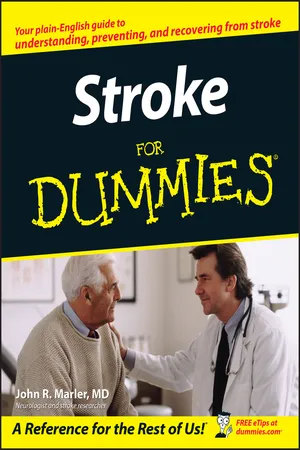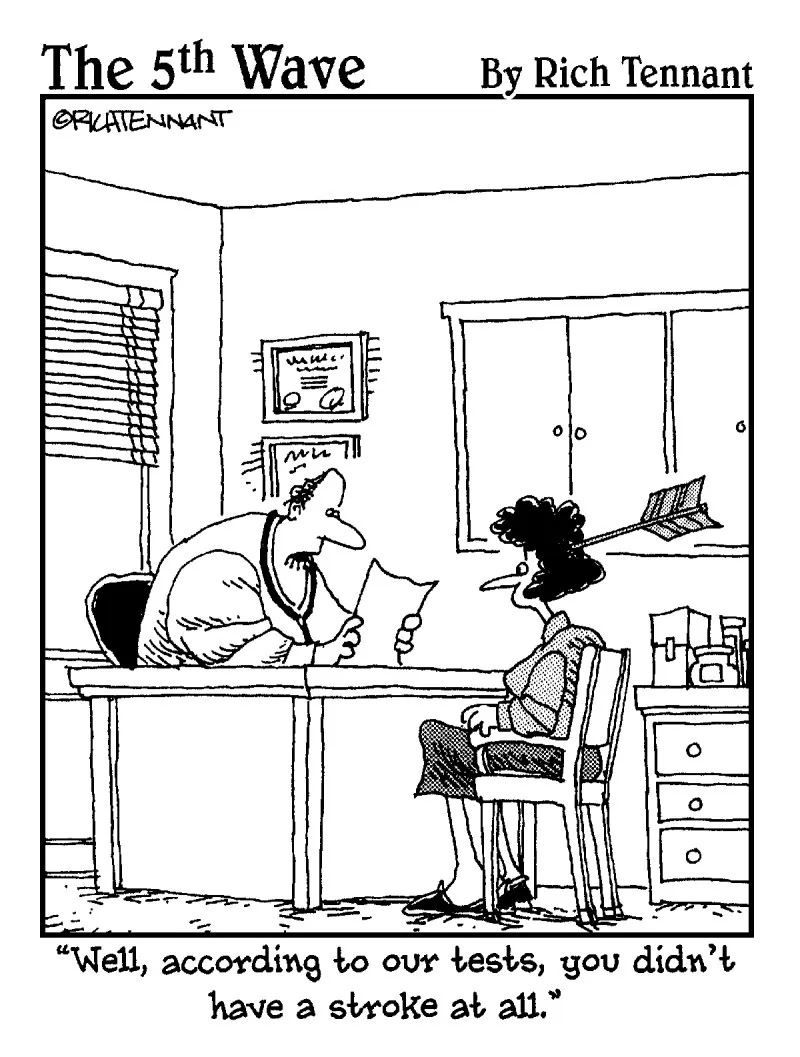
- English
- ePUB (mobile friendly)
- Available on iOS & Android
eBook - ePub
Stroke For Dummies
About this book
Features tons of advice for recovery and rehabilitation
Get the latest on the symptoms, diagnosis, and treatment of stroke
Have questions and concerns about strokes? This reassuring guide provides invaluable information for stroke victims and their loved ones, from what a stroke is and what it feels like to proven treatments and therapies. You'll see how to implement a plan for preventing stroke, treat the lingering effects of stroke, and maximize home caregiver effectiveness while minimizing fatigue.
Discover how to:
- Understand what causes different types of stroke
- Recognize warning signs
- Get the most out of doctors and hospitals
- Speed recovery with the best treatments
- Help prevent future strokes
- Decide the best living arrangements after stroke
Frequently asked questions
Yes, you can cancel anytime from the Subscription tab in your account settings on the Perlego website. Your subscription will stay active until the end of your current billing period. Learn how to cancel your subscription.
No, books cannot be downloaded as external files, such as PDFs, for use outside of Perlego. However, you can download books within the Perlego app for offline reading on mobile or tablet. Learn more here.
Perlego offers two plans: Essential and Complete
- Essential is ideal for learners and professionals who enjoy exploring a wide range of subjects. Access the Essential Library with 800,000+ trusted titles and best-sellers across business, personal growth, and the humanities. Includes unlimited reading time and Standard Read Aloud voice.
- Complete: Perfect for advanced learners and researchers needing full, unrestricted access. Unlock 1.4M+ books across hundreds of subjects, including academic and specialized titles. The Complete Plan also includes advanced features like Premium Read Aloud and Research Assistant.
We are an online textbook subscription service, where you can get access to an entire online library for less than the price of a single book per month. With over 1 million books across 1000+ topics, we’ve got you covered! Learn more here.
Look out for the read-aloud symbol on your next book to see if you can listen to it. The read-aloud tool reads text aloud for you, highlighting the text as it is being read. You can pause it, speed it up and slow it down. Learn more here.
Yes! You can use the Perlego app on both iOS or Android devices to read anytime, anywhere — even offline. Perfect for commutes or when you’re on the go.
Please note we cannot support devices running on iOS 13 and Android 7 or earlier. Learn more about using the app.
Please note we cannot support devices running on iOS 13 and Android 7 or earlier. Learn more about using the app.
Yes, you can access Stroke For Dummies by John R. Marler in PDF and/or ePUB format, as well as other popular books in Medicine & Diseases & Allergies. We have over one million books available in our catalogue for you to explore.
Information
Part I
The Brain and Stroke

In this part . . .
**IN a DROPCAP**
W hat is stroke, what does it do to the brain — and how and why does it do this? These are a few of the questions I tackle in this part. I begin in Chapter 1 by describing the process and mechanisms of the different kinds of stroke. Chapter 2 covers the basics of how the brain does what it does and how stroke disrupts its natural workings.
Chapter 1
A Brain Attack
In This Chapter





L et me hit you with the bad news first: Stroke kills, stroke destroys, stroke debilitates. Stroke is the third most common cause of death in the United States, and the number-one cause of serious disability. One year after the most common kind of stroke, approximately 30 percent of those afflicted will have died, and another 30 percent will have a moderate to severe disability.
Now for some good news: Of those who experience the most common type of stroke, approximately 40 percent are left with only a mild or no disability one year later. And each year more people survive and recover from stroke as medical research continues to advance effective treatment. Today, recovery with improvement is the rule rather than the exception.
Stroke is sometimes called a brain attack. I wish this label would catch on, because I think that people might then understand that stroke is an emergency — like a heart attack — and call 911 right away! A heart attack threatens your heart; a stroke threatens your brain. In truth, most stroke is like a heart attack: It’s a problem with blood vessels, and time is really important. However, heart attack is a little easier to recognize. First of all, the pain tells you something is wrong — and it is usually near your heart. Most strokes are painless, and the symptoms, a paralyzed arm or leg for instance, are not obviously related to the brain.
Clearly, the more you know about stroke — its symptoms, causes, risks, treatment, and prevention — the better your chances of living a full and productive life with or, better yet, without stroke. And the first lesson is to learn what stroke is and how and why stroke occurs.
If you’ve already had a stroke, there are many opportunities to reduce the disability that stroke causes and prevent another stroke attack. A serious stroke will affect your entire family. You can fight back together.
-plgo-compressed.webp)
Real-life examples
A 57-year-old man arrives early at work to prepare for an important presentation he has to make at 10 a.m. At about 9:15 he notices a headache. He thinks this is unusual, because he doesn’t have many headaches. He remembers that he did forget his blood pressure medication. He continues to work for a few minutes and then notices his right hand is not working and he can’t concentrate. He calls for his assistant who finds him looking very unusual. His mouth is twisted. He starts to talk but his speech is difficult to understand. She asks if he is okay. He says no. He starts to get up but his right arm gives way and he almost falls. His assistant calls 911.
A 68-year-old woman is preparing breakfast for herself and her husband. He has made the coffee and is reading the newspaper. He hears her drop a plate and looks up to see her standing and looking at her left hand. He asks her what’s wrong. She says she doesn’t know. Her face — particularly the way she is holding her mouth — looks unusual. She keeps looking at her hand. “My hand is numb,” she says. He asks her to sit down. She seems confused as he leads her to a chair. He asks if it hurts. She says no. “I think you’re having a stroke,” he says. He dials 911.
A 38-year-old lawyer is out jogging on a canal towpath. She starts to feel pain in her head that gets worse and worse. She stops, puts her hand to her head, and falls to the ground. A man walking ahead of her sees her fall. He runs to her but she is unconscious. He pulls out his cellphone and dials 911.
Attacking Out of the Blue
Stroke is nothing if not fast. Each year, as many as 750,000 people in the United States suffer a sudden and unexpected attack of the brain. When part of the brain is deprived of oxygen — which is what is happening when stroke hits — it doesn’t take long for the catastrophe to make itself evident. A minute or less.
Whether it’s a sudden inability to speak, the crash of a dish from a hand that can no longer grasp, or loss of consciousness, a brain attack strikes its victims quickly and powerfully and without warning.
Or does it? Although your stroke may occur in a lightning flash, it has most likely been years in the making, with conditions such as high blood pressure, high cholesterol, obesity, and diabetes possibly serving as warning signs that the brain is in danger. Basically, as these conditions cause wear and tear on your blood vessels, your risks increase of suffering either a blockage or rupture of a brain artery. And — suddenly — you’re in stroke mode.
So how does it happen? It starts with the brain.
Going to the source: Stroke is...
Table of contents
- Title
- Contents
- Introduction
- Part I : The Brain and Stroke
- Chapter 1: A Brain Attack
- Chapter 2: Understanding How the Brain Works
- Part II : Types of Stroke
- Chapter 3: White Stroke (Ischemic): Blood Clots Block the Brain
- Chapter 4: Transient Stroke (TIA): Warning Sign
- Chapter 5: Red Stroke (ICH): Bleeding Inside the Brain
- Chapter 6: Red Stroke (SAH): Bleeding Outside the Brain
- Chapter 7: Dementia (Vascular Cognitive Impairment)
- Part III : Preventing Stroke
- Chapter 8: High Blood Pressure
- Chapter 9: Fat and Stroke Risk
- Chapter 10: Other Risk Factors and Prevention
- Part IV : Treating Stroke
- Chapter 11: Get Thee to an Emergency Room
- Chapter 12: Treating Stroke in the Hospital
- Chapter 13: Rehabilitation
- Part V : Living with Stroke
- Chapter 14: Returning Home: Adapting to a New Life
- Chapter 15: When You Can’t Go Home Again
- Chapter 16: Challenges During Recovery
- Chapter 17: Taking Care of Family
- Part VI : The Part of Tens
- Chapter 18: Ten Ways to Help Your Community Manage Stroke
- Chapter 19: Five Remarkable Stroke Recoveries
- Chapter 20: Ten Opportunities to Prevent Stroke
- Glossary